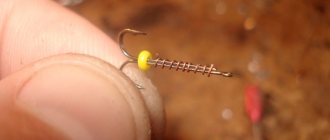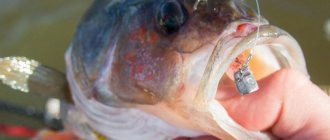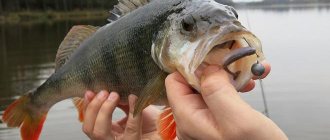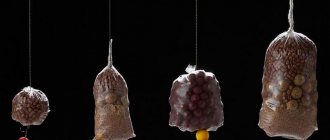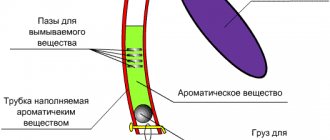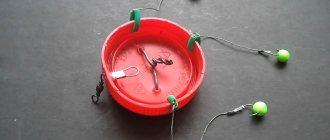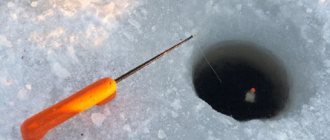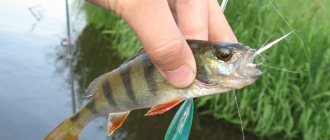This part of the review includes sinkers, jig heads, hooks and silicone baits typical for microjigging.
In microjig, as in regular jig fishing, two main types of bait equipment are used - using jig heads and articulated, with “Cheburashka” sinkers. I’ll say right away: finding a suitable jig head is not so easy. The market and, accordingly, manufacturers are still more focused on classic jigs, so the search for jig heads weighing up to 5 grams is often like a lottery - even in the capital: whether you buy something or not remains unclear until the last moment. In principle, if you do not take into account the products of individual artisans and expensive Japanese jig heads comparable in price to decent spinners, it makes sense to consider two options - products of Russian and Polish companies.
Russian jig heads are still a rather exotic option. They are only produced serially in Tula, where the production of the widest range of lead products is established, including for microjig (photo 1, above) - from 1.5 to 5 grams, which is what we need. They look quite nice, and those who like the maximum similarity of the bait to its natural prototype will definitely like it. There are no complaints about the quality of the hooks - they are exactly what they should be. The price of Tula jig heads, however, may seem high, but it’s worth it, especially when compared with homemade jig heads on powerful hooks of far from the best quality, the weight of which rarely corresponds to the advertised weight.
Jig heads from Polish manufacturers are perhaps the most affordable option. First of all, we are now talking about Dragon V-point heads, which are most often found on the shelves. They are made carefully, the weight corresponds to the declared value. There is no “tooth” for fixing silicone baits, but on the shank of the hook there are several barbs that hold the twister or vibrotail (photo 1, below). The quality of the hooks, however, is inferior to the “Japanese” and “Russian” ones, but not so much that it significantly affects the fishing results. By the way, despite the fact that the hooks are quite powerful, they unbend on the hooks without any problems, after which they can be returned to their original appearance with your fingers. In cluttered places this quality is valuable, especially considering that they allow up to five to six extensions and bends. For those who need “cheap and cheerful” this is a great option. As an advantage, I would like to note a fairly wide range (the weights of the offered jig heads are from 0.8 to 6 grams), in addition, jig heads of the same weight can be produced with hooks of different sizes (photo 2).
By the way, choosing the appropriate hook size is a responsible matter. Pay attention to photo 1, which shows two models of approximately the same mass (lower - 3 g, upper - 2.5 g). As you can see, the difference in hook sizes is noticeable, and this should also be kept in mind when choosing. A larger hook ensures fewer empty bites (it almost always ends up in the fish’s mouth), and there are fewer escapes from it. In addition, such hooks are usually made from thicker wire, so they do not cut through the silicone bait so much, and the likelihood of them unbending when fishing is low. On the other hand, a large hook seriously limits the mobility of the silicone bait, which is especially noticeable when using very miniature “silicone” that resembles a worm or larva. A small hook, on the contrary, allows the bait to move more naturally, but at the same time gives a greater number of empty bites and escapes. What to choose is up to you, depending on the specific situation on the pond; in this case, it is highly desirable to have jig heads of the same weight, but with different hooks. From my own experience, I can say the following - jig heads with a large hook are better used with twisters, and to equip vibrating tails and fancy silicone baits, it is worth using smaller hooks with a short shank.
Regarding the shape of the jig heads used, I can only say one thing - there is not much choice yet. “Ballhead Jig” is a basic variety, which is quite sufficient in the vast majority of situations. But the “Fishhead Jighead” is less universal, although sometimes its use is justified - it sways a little in the flow of water, which adds variety to the behavior of the silicone bait. The use of Fishhead is especially justified when there is a pronounced horizontal component in the wiring (say, with pelagic jigging or even with uniform winding of the line). Sometimes there are not enough jig heads like Football Jig (photo 3), especially relevant on a cluttered bottom, but I want to believe that over time they will widely appear in weight distributions suitable for us.
The situation with microjig “Cheburashkas” is simpler - their production is well established. In addition, you can make them yourself without much labor (you can read about how to do this in the article Making a fastener, a weight head, and a turbine for an ultralight spinning rod). When choosing purchased sinkers, you should only pay attention to the strength of the “ears” - sometimes the loads on them are considerable, so they should not jump out of the lead. It is advisable that the weights be marked with their weight (photo 4) - a difference of 0.5 - 1 g is visually unnoticeable, so sooner or later you will definitely get confused while fishing.
Weights with the so-called “free ear” deserve special mention, allowing you to load the bait as quickly as possible (photo 5). In addition, there is no need for winding rings, and the bait itself becomes more compact, which plays an important role in microjigging. Such sinkers are less common on sale, but they are worth looking for. Fortunately, the release of cargo with a “free ear” has begun to improve, including those necessary for us (photo 6).
Perhaps the only disadvantage of such “Cheburashkas” is that sometimes when fishing, the load jumps onto the fishing line, rising quite high along it (photo 7). The reason for this is the use of thin wire in their production, the “ears” of which, under load, simply cannot stay in the body of the sinker. This entails two problems - firstly, the fishing line or cord can be damaged by a load sliding along it, and secondly, the “clip” that remains without a rigid fixation has every chance of unbending (or simply the hook can jump off it when the fish jerks) . However, I’m still exaggerating – this doesn’t happen very often, so it’s just a possible scenario that needs to be kept in mind.
Micro jig hooks
The situation with hooks for Cheburashkas is as follows. In principle, you can use both single hooks and doubles with tees, but I would still recommend sticking with single hooks - an increase in the “hook equipment” is unlikely to affect the implementation of bites, but the “spirit of microjig” will significantly undermine. Microjig is, first of all, creative fishing, where you try to catch fish by correctly selecting and presenting bait, and not by increasing the number of hooks.
Not every hook is suitable for equipping microjig baits. Imagine an ordinary winding ring of minimal size. It is with its help that the hook and sinker are connected. In this case, the movement of the hook should not be limited by the ring, so its eye should be large enough for the ring to move freely, without jamming. Not every hook meets these requirements. For a long time, perhaps the only suitable option was specialized hooks from Owner, created to equip wobblers and “micro-oscillators”. More precisely, there are several such series; hooks of the S-29 and S-31 series are more suitable for us (photo 8). The main option is still S-31 No. 4 and 2, they are suitable for almost all microjig baits and fish of any size. Hooks of the S-29 series are made of thinner wire; they should be used only when catching “sports” perch with the smallest baits (1 - 1.5 inches) and with the lightest possible loads (photo 9). Such hooks are not designed for significant loads; moreover, after a couple of hooks with extension, they simply break - unlike the same “31s”, which can withstand 4 to 5 cycles of extension and bending. These hooks have a small beard, so it is better not to give any slack when fishing.
Not long ago, hooks appeared on the shelves of some stores, which can significantly displace Owner. We are talking about Decoy Area Hook Type IV Eric singles (photo 10). They are also designed for equipping artificial baits, differing from the Owner in a slightly different bend shape, quality of wire and sharpening. These models have no beard at all, so the process of removing the fish from the hook and releasing it into its native element occurs most quickly and painlessly. For our purposes, hooks No. 6 - 2 are suitable. In general, Decoy has several families of “bait” hooks, but Eric seemed to me the most suitable for microjigging. However, perhaps this is due to the extremely poor selection of these hooks in stores, and in fact there is something even more interesting for us. Wait and see.
Of course, the choice of microjig hooks is not limited to the two mentioned manufacturers. You can find a suitable model from “budget” manufacturers - like Cobra or Mikado, and from more “reputable” Kamasan or Gamakatsu. At the same time, the eye of the hook does not have to be very large; hooks from the Baitholder series (with barbs on the shank), which are present in the assortment of most manufacturers, are quite suitable (especially if weights with a “loose eye” are used). The main thing is that the hook size matches the size of the bait. However, Owner and Decoy were not mentioned by chance: after numerous experiments, I settled on them; of the options I tried, they have no equal in terms of the convenience of equipping baits and implementing bites.
A separate issue is the use of offset hooks in microjigging. For a long time this question did not even arise - the small lugs of most “offsetters” of suitable size simply did not make it possible to equip them with a sinker and a winding ring. The appearance of “free-eared Cheburashkas” changed the situation - connecting the hook directly to the load (photo 11) made it possible to push the issue of eye size into the background. So when fishing in “strong” places, it is quite possible to use medium-sized offset hooks from the assortment of the same Owner, Gamakatsu or Sasame. Another question is: is it worth doing? The microjig itself is not the hookiest bait, especially since it is often not the hook itself that catches, but the sinker that gets stuck between stones or branches - and here no “offset tool” can save you. But the number of bites drops quite noticeably - it’s good if by a factor of two, and usually more, only every fourth or fifth fish that bites can be brought to the shore. So, as it seems to me, the use of offset hooks in microjig is not justified, and they should be used only where otherwise the bait would get caught on every wire.
What to choose - a swivel rig or a jig head? Here, too, everything is ambiguous. Hinged rigging means longer casting, freer “play” of the bait and more confident fishing. The jig head gives a head start in the ease of equipping the bait and in a more confident and reliable hooking. Which of these is more important is up to you to decide. And it’s even better to have both in stock; they won’t take up much space in your pocket or box. In my opinion, articulated rigs are more suitable for catching perch (photo 12) and for equipping twisters and “fantasy” baits (“crustaceans”, “nymphs”, “larvae”, etc.), but it is better to equip vibrotails with jig heads , especially if, in addition to perch, goby (photo 13), bersh or pike perch (photo 14) can be prey.
How to fish with a microjig - a necessary educational program for beginners
It cannot be said that microjig is the most interesting or outstanding method of spinning fishing. This is just another method and method, for mastering which it is not enough to collect the appropriate gear, you need to understand it from the very basics in order to experience the beauty of such fishing.
The action of the bait, the retrieve and the bite are most often monitored by the tip (in the presence of a cord and larger baits) and by the sag of the fishing line on the smallest scales. It is important to be able to track and separate the behavior of the bait from the fish bite; this comes with experience.
Any unusual behavior of the fishing line is a bite.
Microjig is a short but accurate cast, almost always. You often have to cast to local promising points. Therefore, it is better to hone the casting technique, especially for beginners and on new gear, on land.
If perch or other fish often disappear, you should change the line to fishing line/flure, and the bait to a smaller one.
Crucian carp on ultralight:
Micro jig wiring
In microjig it is important to master as many animations as possible. This will allow you to diversify the behavior of the bait and cause the fish to bite.
Three methods are used - playing with a reel, pulling with a rod, or a combination of both on one retrieve.
Short rhythmic jerks with or without pauses are good at provoking perch, pike and pike perch to bite.
A double jerk, pause 1/2 second and repeat is also good for perch.
For peaceful fish, uniform movement of active baits is also used, as well as various animations almost on the spot with play along in the water column, if these are slugs/worms and other passive baits. A kind of dance occurs with the bait with a minimum speed of retrieving in the horizontal component of the retrieving.
The passive predator responds well to the movements of the bait on the bottom, without active jerks.
A classic step along the bottom or in the water column is possible either on scales from 3 grams, or with the most delicate high-quality tackle, or by monitoring the behavior of a slack fishing line - but this last method of indicating bites is suitable for an experienced fisherman - a microjigit.
You should not expect a bite in the hand on a characteristic microjig on small scales!
Also a good provocateur will be animations with simultaneous rotation of the reel with pauses and playing along with the rod using jerks and pulls of various frequencies and amplitudes. This is a labor-intensive and technically complex process, but it gives excellent results.
In general, it is good to vary the types of animations within one posting and select a new set of animations for each new posting. We play with bait and a game with the fish - who wins?
Catching perch in the spring with a microjig:
Tricky microjigging for perch in a video master class from an expert:
Tactical fishing scheme: search, presentation, weather
A good result when fishing with a microjig is obtained by constantly moving around the reservoir in search of promising sites. Beginning microjiggers, having adopted experience from “hard” fishing for channel or pit pike, can cast even a promising place for hours - this is a road to nowhere. You need to move on if there are no bites after 5-7 casts.
If such a catchable place is found, you need to purposefully catch it with precise, accentuated casts, but also without staying on it for very long - this is boring and not promising in terms of finding new, more interesting points/fish. So, for example, you can switch from perch to a school of rudd, then find a larger perch, and then find a site of grass pike and vice versa.
Microjig - movement!
Also, don’t forget about changing baits - active/passive, shape, size, color, everything can make a difference in microjig fishing. The fish quickly gets used to one bait and stops actively reacting to it. Therefore, it is necessary to either change the fishing location, or change the bait, or both.
Fishing in the rain gives good results, especially when it follows a long period of heat and the air and water temperatures drop.
The movement of schools of perch, rudd, and roach can be tracked by the behavior of seagulls, which always circle above the schooling fish, and literally follow on the heels of such boilers.
Microjig lures
Perhaps this is what arouses the greatest interest in the fishing community when it comes to any method of fishing. This is understandable - a spinning rod or reel is usually bought for at least several seasons, and one should only be interested in the gear of colleagues for general development, but lures are, whatever one may say, “consumables” that do not last long for a practicing fisherman. Whether you like it or not, snags and breaks happen regularly when fishing with a microjig, so the supply of “silicone” has to be renewed periodically. In addition, if the choice of a suitable spinning rod or reel primarily affects the convenience of fishing for the fisherman himself, then the success of fishing directly depends on the bait, because it is the predator that bites on it.
I probably won’t write too much about silicone baits - a whole article, or even more than one, could be devoted to this topic. I will, perhaps, limit myself to recommendations on the selection of lures for microjigging and a description of several models, the performance of which I am 100% sure of. In my opinion, understanding the general principles of choosing the right silicone bait will be much more useful than searching for specific baits, especially since they will not always be a panacea for lack of biting.
Color of silicone bait for microjig
The color of silicone bait, one of the most popular topics in the conversations of spinners is the influence of the color of the bait on the bite of fish, and opinions here are very different - from completely denying this influence to giving it a key role. But the truth, in my opinion, is, as always, somewhere in the middle. Of course, in some way the color of a silicone bait affects its attractiveness to a predator (it’s not for nothing that God gave it eyes), but you shouldn’t put it at the forefront - the right choice and presentation of the bait is much more important.
According to my observations, in any situation and on any body of water, baits of three fundamentally different colors are enough to arouse the interest of a predator. In principle, all bait colors existing today can be divided into 3 large groups - “natural light”, “natural dark” and “acid” (photo 15), and it is the difference between them that is sometimes fundamental. This is especially evident with wobblers. If, for example, I know that a certain model is currently working well on a certain body of water, then if I take it in three colors (say, silver, dark gold and Fire Tiger), in any case I will not be left without bites - regardless of fish activity, water transparency and other factors. With silicone baits, the situation is generally the same - there is simply no need to buy catchy baits in all possible colors.
Let's move on to specifics. The easiest thing is with “acid” - just one fluorescent green color is enough to close this category once and for all. It’s more difficult with light-colored baits - traditional white and black colors don’t always work. Much more promising are all sorts of translucent colors and phosphorescent silicone baits, usually designated by the term glow (or “luminous”). An alternative option is regularly “shooting out” pink and orange colors, which can no longer be called natural, but they are still far from “acid colors”.
With dark-colored silicone baits the situation is more complicated, if only because in most cases they form the basis of the microjigit’s arsenal. This is understandable - it is dark baits that are most similar to crustaceans, larvae and other boogers that fish feed on, and objective statistics so far indicate that the predator prefers these baits in most situations. Of all the dark colors, I would highlight four that are noticeably different from each other and consistently bring results (let me remind you, we are talking, first of all, about catching perch with a microjig). These colors are “machine oil”, “beer/tea with pepper”, swamp green and purple (photo 16). At the same time, it is not necessary to chase exactly those colors that are shown in the photo, they simply demonstrate a certain guideline. In fact, it doesn’t matter at all whether your green bait will be darker or lighter than mine or how much purple tones will predominate in its color (from a barely visible tint to completely purple) - the difference in the number of bites, if it happens, is minimal.
Is it really necessary to have “silicone” of all the indicated colors with you? Of course not. I usually take with me a pack of “acid” baits, one or two packs of light baits and two or three packs of dark “rubber” of different colors - this is more than enough in the vast majority of situations. Well, if this is too much, then you can limit yourself to a set of twisters of orange, green and brown colors - you are unlikely to be left without a catch.
Edible silicone baits
The “edibility” of silicone prianks is a question that increasingly excites the minds of spinning anglers. There is more “edible rubber” on the shelves almost every day, and if previously these were mostly quite expensive Japanese baits, now you can easily buy their cheaper, but no less catchy copies without much difficulty. But is this justified?
First, let's define the terminology. Strictly speaking, real “edible rubber”, if not edible, is at least biodegradable - over time, its material breaks down into separate components that are safe for nature. Information about this can be found on most packages of Japanese baits (photo 17). In our country, this term is usually understood more broadly - as “silicone”, which makes the fish want to eat it with its taste or smell. Let's stop here - from a practical point of view, this is more significant for us.
As my experience of fishing with “edible silicone” shows, the presence of smell and taste in some situations can really play a significant role, especially if the predator is passive. It happened more than once that the fish did not pay any attention to the usual baits, but as soon as you put in something “edible”, a perch immediately appeared, rushing to try the treat offered to it. And the effectiveness of bites increased many times over - the sensitive tackle made it possible to feel how the perch was literally chewing on a stationary silicone bait without losing interest in it. When catching an active predator, the difference, of course, is not so noticeable, but how often is it active in our country? So, if possible, it is very desirable that the bait be “edible”; if not, the fish may have to be persuaded to bite longer.
Forms of silicone baits for microjig
If in classic jig almost all silicone baits used can be classified as either twisters or vibrotails, then in microjig the choice of their forms is much wider. You won’t see anything on the hook of microjigits - various “worms”, and “leeches”, and “crustaceans”, and “larvae”, and even creatures that have no analogues in nature. Is such diversity necessary? In my opinion, it is necessary.
I’ll leave aside the question of the similarity of silicone bait to the natural food source of fish - hundreds of predators caught with all kinds of “crackers” indicate that this issue worries mainly the fishermen themselves. Much more important is the “game” created by the silicone bait. It is well known that when hunting, predatory fish focus mainly on the lateral line, so they must first be attracted by water vibrations, and only then by the appearance of the prey. Now let's take a regular twister. Whatever is written on it - Berkley, Relax or even Ecogear - its behavior in water will not change much, the body will remain motionless, and the tail will oscillate with one frequency or another. This is not bad, but where the fish sees (and feels) dozens and hundreds of such twisters per day, it is unlikely to attract its attention (especially if the predator has already been on the hook before). But if you attach legs to this twister, make the body ribbed, or pierce a couple of holes in the tail, then its outward behavior may remain the same, but the silicone bait will “sound” in the water completely differently, and is unlikely to alert even the “punctured” "predator. What can we say about “silicone” with an even more exotic appearance. That is why the greater the variety of forms of bait you use, the greater the chances of success. However, when using “edible silicone” this can be achieved without much difficulty - most of these baits have at least a non-standard appearance.
Perch and pike perch on microjig
Large perch are more clumsy than pike, and are often quite lethargic and indifferent to active silicone baits. Therefore, more often the perch attacks small worms or crustaceans, ignoring active micro-baits that imitate agile fry. However, during periods when perch is actively hunting, it is appropriate to use small twisters and vibrotails. In the case of pike perch, the situation is most unpredictable, since this predator can bite well on both active and passive silicone.
My best catchable silicone baits for microjigging
Now, perhaps, it's time to talk about specific silicone baits that I would recommend to anglers who want to master microjigging. Of course, you should not limit your choice only to them, but, as practice shows, these models consistently produce results in almost any conditions.
First, I’ll say a few words about ordinary, “inedible” twisters. Despite all of the above, they continue to work - and for many of us they remain the No. 1 bait. There is a wide choice of them now, and it is hardly worth chasing after any specific models. For example, the difference between the small silicone lures Mann's, Relax and Mikado is so insignificant that it is unlikely to affect the fishing results. And the color range of twisters from these manufacturers is rich in saturation - in any case, from several dozen colors, you can choose something suitable. Recently, I have almost completely switched to relatively new twisters from the Baltic company Lucky John of the Micro Jig 2 and 3 series (photo 18), as well as Surprise 3 (photo 19). In terms of their performance characteristics (softness, strength, etc.), they completely suit me, and among almost three dozen colors, those that our fish like are predominant. Micro Jig are the most common classic twisters with a length of 25 and 35 mm. Surprise is interesting in that the end of its tail is made in the form of several tentacles, which adds variety to its behavior. An important fact for many of us: a package of two dozen silicone baits costs about 60 rubles in stores, so even a solid supply of them won’t hurt your wallet too much.
Since we’re talking about the “silicone” Lucky John, I’ll tell you about another bait that belongs to the “edible” Tioga series (photo 20). Outwardly, it is a kind of hybrid of a silicone “worm” and a vibrating tail: from the first there is an elongated ribbed body with a characteristic thickening, from the second there is a drop-shaped tail of medium size. The bait is 2 inches long and has a fairly strong fishy smell. It is better to equip it so that the hook does not extend beyond the annular thickening in the head part - this is how it “plays” as lively and realistic as possible. Tioga is distinguished by its mobility, works even on the slowest retrieve, and consistently attracts a wide variety of fish, perch, goby, medium-sized pike perch and pike. Excellent for both classic stepped and uniform wiring.
The next interesting model is the 2-inch Slit Shad from Sakura (photo 21). It would seem that there is nothing particularly outstanding - the shape is standard, there is practically no smell (especially in comparison with competitors), the “game” is common for all vibrotails. However, this bait catches fish surprisingly consistently, regardless of its activity. There were times when the predator didn’t take anything else at all, and the Slit Shad, albeit rarely, brought bites. The vibrotail is not picky about equipment; it works well even on heads with large hooks. If necessary, you can equip the bait with an “offset gun”, hiding its sting in a special recess in the back. Retrieving most often works slowly, with the bait dragging along the bottom and pausing.
Vibrating tail Molix Virago
Another interesting European vibrator is Molix Virago. These baits have only recently appeared on the market, but I managed to fish this year with pre-production samples from a special set, so I already have experience in using them. We're interested in the 2-inch-long Virago (photo 22). Although the series also includes baits several times larger. The vibrating tail is made of a rather hard and elastic material, the tail is small, fork-shaped, with a kind of keel at the bottom. Due to this, the bait’s own “play” is not very expressive; when retrieving, the tail only vibrates slightly, almost imperceptibly to the eye. Its main feature is that the vibrotail is made to float; in its body there is a cavity with an air bubble. In this regard, it is better to use the bait on a hinged mounting, otherwise it loses all meaning. Since the internal cavity is made open (there is a small hole in the abdomen), a couple of drops of attractant can be poured inside it to enhance attractiveness. The Virago works best with dragging a weight along the bottom and small “steps”; its main catch is perch.
Pontoon21 Awaruna
Pontoon21 Awaruna (photo 23) went on sale earlier this year. Models 1.5 and 2 inches long are suitable for microjigging; in general, the series includes lures up to four inches long. The appearance of “Avaruna” is easily recognizable - on the one hand, it is standard for a vibrotail, on the other, the “ribs” on the abdomen and a rather large trapezoidal tail are the family features of this bait. For me, Awaruna works best on articulated rigs; jig heads quite significantly limit the mobility of the bait. The “game” of this vibrating tail is active, it easily “winds up”, wagging its tail seductively even under the influence of the current. I also note that the material from which it is made is quite durable and can withstand more than one bite. The smell of the bait is not too strong, but, apparently, quite sufficient. An additional plus is 25 attractive colors, selected taking into account the preferences of the Russian predator.
Keitech Swing Impact
The two-inch Keitech Swing Impact (photo 24) often helps out even in the most “uncool” hours. The vibrotail is made of very soft plastic with a strong squid smell, has an elongated ribbed body and a large tail blade. The unusual cross-sectional shape of the bait (the body is flattened at the top in the head and on the sides at the tail), as the developers say, gives it a unique “game.” I don’t know how unique it is, but the fish really like it, and the most varied ones - from pike perch and perch to the seemingly peaceful ruff (photo 25). The vibrating tail plays very lively; it is better to equip it with hooks with a short shank that minimally hinder movement. A significant disadvantage of this model is its low strength, it rarely withstands more than three to four bites, and the hook gradually breaks. Perhaps, on very important fishing trips it is very desirable to have a Swing Impact in your arsenal, but in other cases it is still better to use something simpler or stronger, otherwise the caught fish will be truly “golden”.
Bait Breath Fish Tail
Bait Breath Fish Tail (photo 26) was the main discovery of this year for me. During the first fishing trip with this bait, it turned out that the perch only took it, completely ignoring other “rubber”, and it was possible to find fish even where there had been no bites at all before. So I believed in Fish Tail right away, and then this belief only grew stronger. There were even cases when I caught a “striped fish” on a bet in a seemingly unpromising place from the very first cast. The size of the prey, however, is usually not encouraging - perches larger than 100 g are rarely caught on 2-inch baits (photo 27). The appearance of the Fish Tail is remarkable - it is a kind of “leech” with a body flattened from the sides and a fish tail that plays seductively when retrieved. This model has a fishy smell, not too strong. Surprisingly, the loss of the tail has almost no effect on the catchability of the bait, except that in this case it is advisable to make more active retrieves. In general, the bait allows for a wide variety of animations - from explosions and dragging to slow, uniform retrieval. Perhaps, if there is a need to take only one rubber model with you on a fishing trip, it will be the 2-inch Fish Tail. True, there are not too many color options for the bait, but it doesn’t matter - the most interesting colors are present here.
Ecogear Rock Claw
The small crustacean Ecogear Rock Claw (photo 28) will appeal to fans of microjig fishing for relatively large predators - it cuts off small things well. The baits have a strong, rather pleasant smell (and judging by the inscription on the packaging, they also have a taste that is attractive to fish). It is better to equip these baits with jig heads with fairly large hooks (otherwise there will be a lot of slips), do the wiring near the bottom, with regular short jerks, as well as dragging the “Crawfish” along the bottom. In our conditions, the Rock Claw mostly catches pike perch, and where there are a lot of large perch, it will be the main prey of the bait. It is noteworthy that all the bites on it are very “angry”, without the characteristic chewing and pinching of the bait - it seems that the predator is trying, without hesitation, to grab the “Cancer” before it uses its claws.
Vetrov A.
What can become prey
One of the advantages of the ULetchik is that the species composition of its catch is not limited only to predatory fish. Often peaceful representatives are also caught on microjig baits.
Of course, the main trophy when fishing with microjig tackle is the ubiquitous perch, which is caught throughout the season. You can catch it on the edges, along and above underwater vegetation, in bays and currents.
Also, from early spring to late autumn, pike, pike perch, chub and roach are caught on edible microsilicon; foals are not disdainful.
But besides this, throughout the warm water you come across relatively peaceful fish - rudd, roach, silver bream, sabrefish, grayling, trout, bream, crucian carp and even tench. The last two, however, are most often used for the most nano-jig silicone micros and tiny foam rubbers.
It’s very exciting and exciting to catch schooling sabrefish using a microjig in early spring, when they roll down from their spawning grounds.
